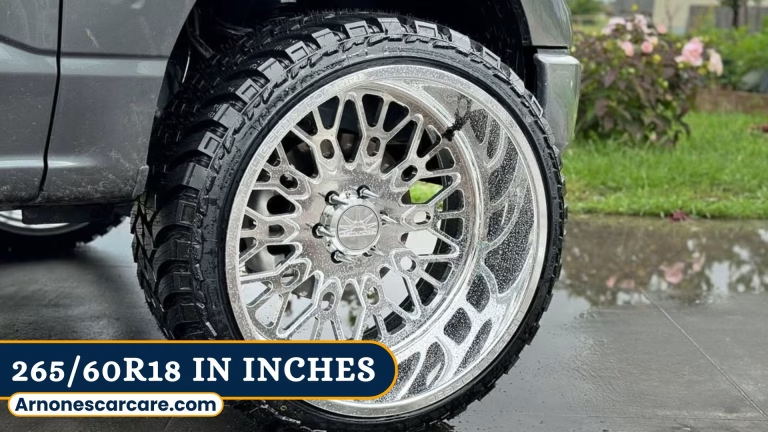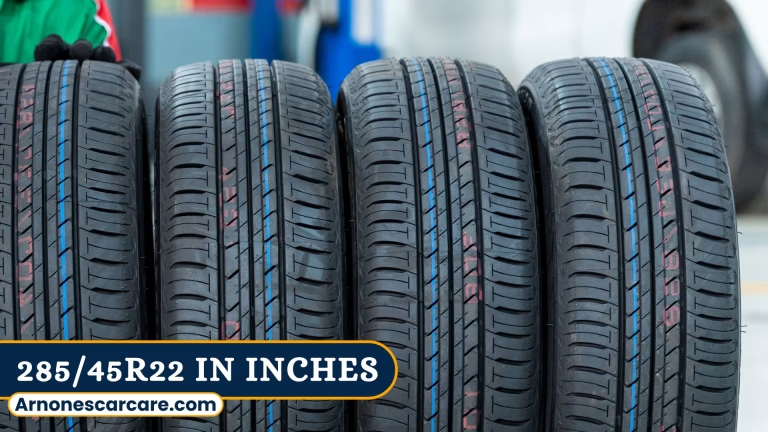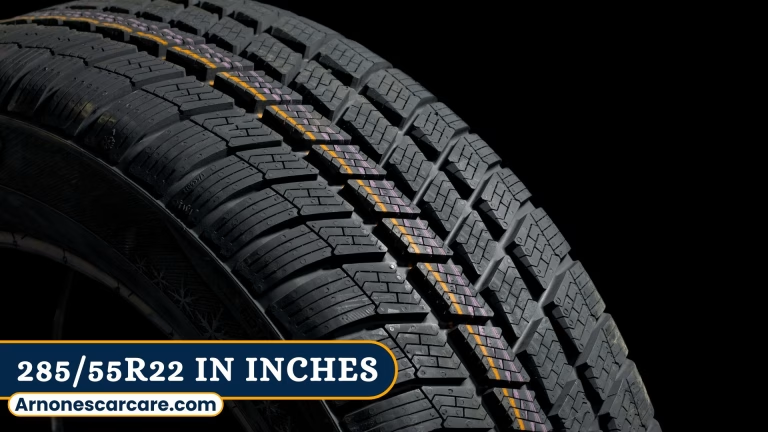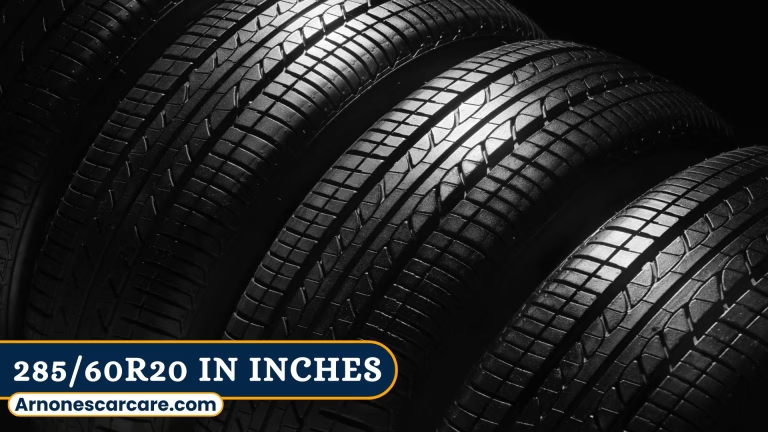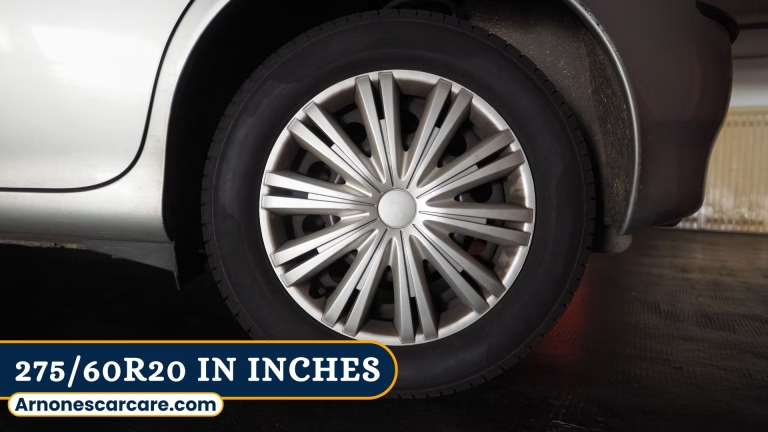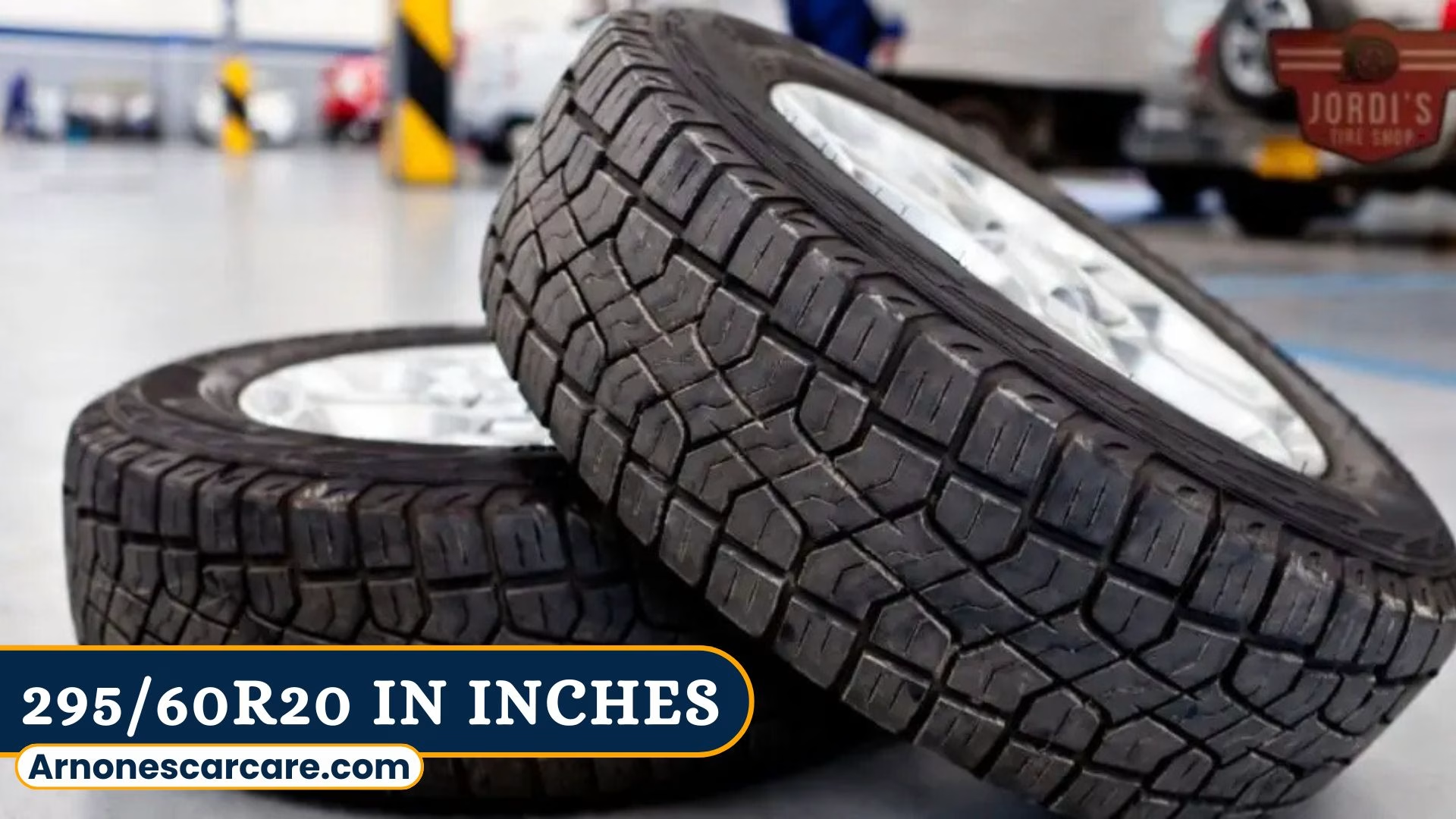
The 295/60R20 tire has an overall diameter of 33.9 inches (861 mm), a tread width of 11.6 inches (295 mm), and fits a 20-inch (508 mm) wheel. Its sidewall height is 7 inches (178 mm), with a circumference of about 106.6 inches (2708 mm), giving around 594 revolutions per mile (369 per kilometer).
This size offers excellent traction, added ground clearance, and a smooth ride, making it a strong choice for trucks and SUVs used in both daily driving and off-road conditions. I also write blogs on different more Tire Sizes, check it for more information to help you make better decisions.
Tire Size: 295/60R20 in Inches & Metric Measurements
To truly understand how this tire will perform, let’s break down the exact dimensions of a 295/60R20 tire in inches and millimeters:
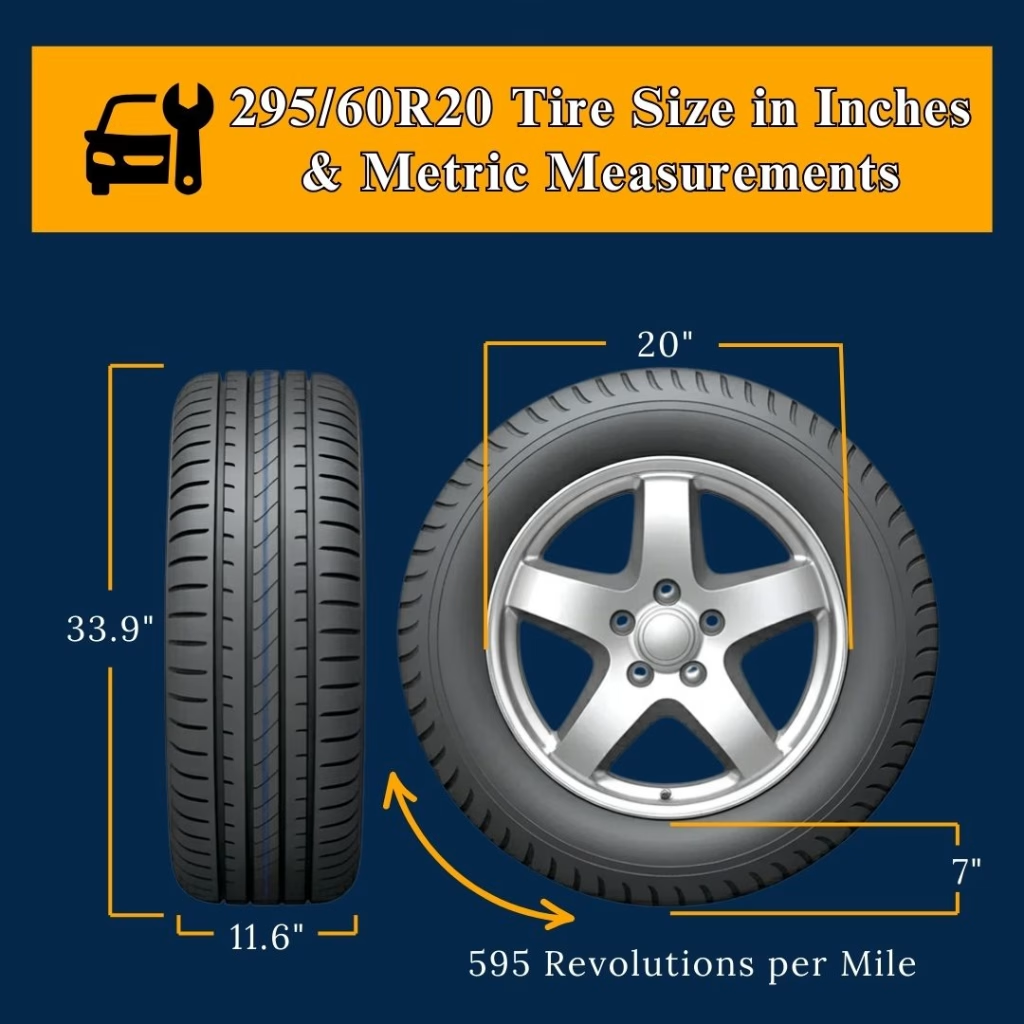
| Measurement | In Inches | In Millimeters |
| Width | 11.6 in | 295 mm |
| Sidewall Height | 7 in | 177 mm |
| Overall Diameter | 33.9 in | 862 mm |
| Circumference | 106.4 in | 2706.7 mm |
| Revolutions/Mile | 595 | 369 per km |
So, why do these numbers matter?
- A wide 11.6-inch tire improves traction and stability, making it a great choice for off-road and heavy-duty use.
- A tall 7-inch sidewall provides a solid balance between ride comfort and durability—it absorbs bumps but isn’t too soft.
- An overall diameter of 33.9 inches ensures better ground clearance, which is useful for off-road adventures.
- The circumference of 106.4 inches affects speedometer accuracy and rolling efficiency.
- 595 revolutions per mile mean the tire rotates fewer times compared to smaller sizes, reducing wear and improving fuel efficiency.
Understanding these measurements helps you determine if 295/60R20 is the right size for your vehicle. It also ensures you’re making an informed decision when comparing with other tire sizes.
Breaking Down the 295/60R20 Tire Code
If you’re wondering what 295/60R20 actually means, you’re not alone. These numbers might look complicated at first, but they provide important details about the tire’s size and construction. Here’s what each part of the code represents:
- 295 – This is the tire’s width in millimeters, measuring from sidewall to sidewall. 295mm = 11.6 inches, giving the tire a wide footprint for better grip and stability.
- 60 – This is the aspect ratio, meaning the tire’s height is 60% of its width. A lower aspect ratio often results in better handling but a slightly stiffer ride.
- R – Stands for radial construction, the most common type of tire structure today. Radial tires are built for better durability and fuel efficiency.
- 20 – This represents the wheel diameter in inches. A 295/60R20 tire is specifically designed to fit a 20-inch wheel.
These numbers aren’t just random—they directly impact how the tire performs on the road. The wider width provides strong traction, the 60% aspect ratio ensures a balance of comfort and stability, and the radial design improves longevity and fuel economy.
Easy Way to Convert 295/60R20 to Inches
When buying new tires, you may need to convert metric sizes to inches for better understanding. Luckily, it’s easy to break down the 295/60R20 size using a simple formula.
Here’s how we calculate the key measurements:
- Tire Width: The width is given as 295mm. To convert to inches:
295 ÷ 25.4 = 11.6 inches - Sidewall Height: The sidewall height is 60% of the width.
11.6 × 0.60 = 7 inches - Overall Diameter: This includes two sidewalls plus the wheel diameter (20 inches).
(7 × 2) + 20 = 33.9 inches - Circumference: Use the formula for circumference:
3.1416 × 33.9 = 106.4 inches - Revolutions Per Mile: Since we now know the circumference, we calculate:
(63,360 ÷ 106.4) = 595 revolutions per mile
Why Do These Conversions Matter?
Knowing these measurements helps you:
✔ Choose the right replacement tires without affecting performance.
✔ Ensure speedometer accuracy since larger or smaller tires can impact readings.
✔ Understand clearance and fitment if upgrading or modifying your vehicle.
Now that we’ve covered the numbers, let’s move on to how these tires perform in real-world driving conditions.
295/60R20 vs Other Tire Sizes – Which One is Best for You?
Choosing the right tire size can be tricky, especially when there are so many options. Here’s how 295/60R20 compares to other popular sizes.
295/60R20 vs 275/65R20 – Slightly Taller, But Narrower
| Feature | 295/60R20 | 275/65R20 |
| Overall Diameter | 33.9 inches | 34.1 inches |
| Width | 11.6 inches | 10.8 inches |
| Sidewall Height | 7 inches | 7.1 inches |
| Circumference | 106.4 inches | 107.1 inches |
| Revolutions Per Mile | 595 | 591 |
Which One is Better?
- Choose 275/65R20 if you want a slightly taller tire that improves fuel efficiency.
- Choose 295/60R20 for better grip, stability, and a bolder look.
295/60R20 vs 295/65R20 – Comfort vs. Handling
| Feature | 295/60R20 | 295/65R20 |
| Overall Diameter | 33.9 inches | 35.1 inches |
| Width | 11.6 inches | 11.6 inches |
| Sidewall Height | 7 inches | 7.5 inches |
| Circumference | 106.4 inches | 110.3 inches |
| Revolutions Per Mile | 595 | 574 |
Which One is Better?
- Choose 295/65R20 for extra comfort on rough roads.
- Choose 295/60R20 for sharper handling and better speed performance.
295/60R20 vs 33/12.5R20 – Off-Road Adventure Tires
| Feature | 295/60R20 | 33/12.5R20 |
| Overall Diameter | 33.9 inches | 33 inches |
| Width | 11.6 inches | 12.5 inches |
| Sidewall Height | 7 inches | 6.8 inches |
| Circumference | 106.4 inches | 103.6 inches |
| Revolutions Per Mile | 595 | 612 |
Which One is Better?
- Choose 33/12.5R20 if you need extra width for off-roading.
- Choose 295/60R20 for a smoother ride and better highway efficiency.
295/60R20 vs 305/55R20 – Wider vs. Taller Tires
| Feature | 295/60R20 | 305/55R20 |
| Overall Diameter | 33.9 inches | 33.2 inches |
| Width | 11.6 inches | 12 inches |
| Sidewall Height | 7 inches | 6.6 inches |
| Circumference | 106.4 inches | 104.3 inches |
| Revolutions Per Mile | 595 | 608 |
Which One is Better?
- Choose 305/55R20 if you want a wider stance and better road grip.
- Choose 295/60R20 for a balanced ride with better comfort.
Best Uses for 295/60R20 Tires – Where Do They Perform Best?
The 295/60R20 tire is a versatile option that works well in different driving environments. Whether you’re an off-road enthusiast or a highway commuter, these tires can handle it all.
Off-Roading – Built for Tough Terrain
If you love adventure and rough terrains, these tires are a great choice. Their wide footprint and durable tread provide excellent grip on:
✔ Mud – Deep tread patterns help prevent slipping.
✔ Gravel & Rocky Terrain – Tough construction resists punctures.
✔ Snow – Some all-terrain models have snow-rated tread designs for better traction.
Best for: Drivers who frequently go off-road or need all-terrain durability.
Towing & Hauling – Stability Under Heavy Loads
With a strong sidewall and wide contact patch, 295/60R20 tires are excellent for towing and hauling. They help keep your vehicle stable and balanced, even when carrying heavy trailers, boats, or campers.
Best for: Truck owners who tow frequently or carry heavy cargo.
Highway Driving – Smooth and Stable at High Speeds
Despite being rugged, these tires still perform well on highways. The moderate sidewall height helps absorb road bumps while maintaining stability at high speeds. However, keep in mind that some all-terrain models may generate road noise.
Best for: Drivers who do a mix of highway and city driving but still want durability.
Daily Driving – Balanced Ride Comfort
For city drivers, these tires provide a comfortable ride while still being tough enough to handle occasional rough roads. However, due to their size, they may slightly reduce fuel efficiency compared to smaller tires.
Best for: SUV and truck owners looking for a good mix of comfort and strength.
Top Brands for 295/60R20 Tires – Which One Should You Choose?
Not all tires are created equal! Choosing the right brand can make a huge difference in durability, performance, and comfort. Here are some of the best brands offering high-quality 295/60R20 tires:
Michelin – Best for Long Tread Life & Highway Comfort
✔ Known for exceptional tread life and smooth handling.
✔ Performs well in wet and dry conditions.
✔ Ideal for highway driving and daily use.
Best for: Those who want long-lasting, quiet, and fuel-efficient tires.
Goodyear – Great for All-Terrain Performance
✔ Features rugged tread patterns designed for both on-road and off-road use.
✔ Some models include Kevlar reinforcement for extra durability.
✔ Provides good traction on wet roads.
Best for: Drivers who need a versatile tire that works well on highways and dirt trails.
BFGoodrich – Tough Tires for Off-Roaders
✔ Built for harsh off-road conditions with deep treads.
✔ Features reinforced sidewalls for better durability.
✔ Strong grip on rocks, mud, and sand.
Best for: Off-road enthusiasts who need a tough and aggressive tire.
Toyo Tires – Great Balance Between Highway & Off-Road Use
✔ Offers good tread life and durability.
✔ Quiet on highways but still capable on dirt roads.
✔ Well-balanced performance for all-season driving.
Best for: Drivers who do a mix of city, highway, and occasional off-roading.
Nitto Tires – Aggressive Tread for Mixed Terrain
✔ Combines off-road capability with on-road comfort.
✔ Deep grooves help with mud, snow, and water evacuation.
✔ Ideal for SUVs and trucks that need versatility.
Best for: Drivers looking for both style and performance.
Budget-Friendly vs. Premium Tires – Which One Should You Choose?
Not sure if you should spend more on premium tires or save with a budget-friendly option? Here’s a quick comparison:
| Feature | Premium Tires (Michelin, Goodyear, BFGoodrich) | Budget Tires (Lesser-Known Brands) |
| Lifespan | 50,000 – 70,000 miles | 30,000 – 50,000 miles |
| Traction & Grip | Excellent in all conditions | Decent but may struggle in extreme conditions |
| Road Noise | Quieter, more refined ride | Can be noisy, especially off-road |
| Durability | Stronger rubber, reinforced sidewalls | Less durable, more prone to wear |
| Price | Higher upfront cost | More affordable but wears out faster |
- Choose premium tires if you want long-term value, safety, and performance.
- Choose budget tires if you need an affordable option for light driving but don’t mind replacing them sooner.
Essential Maintenance Tips for 295/60R20 Tires – Keep Them in Top Shape
To get the most life out of your tires, proper maintenance is key. Follow these simple steps to extend their lifespan and keep them performing at their best.
Check Tire Pressure Regularly
- Why It’s Important: Proper inflation prevents uneven wear and improves fuel efficiency.
- Recommended PSI: Check your vehicle manual for the right tire pressure.
- When to Check: At least once a month and before long trips.
Rotate Your Tires for Even Wear
- Why It’s Important: Front and rear tires wear differently, so rotation extends tire life.
- Rotation Schedule: Every 5,000 to 7,000 miles.
- Best Practice: Follow the recommended rotation pattern in your owner’s manual.
To keep these tires in top shape and ensure their longevity, don’t forget to schedule a Tire Repair service when needed, especially after extensive use on challenging terrains.
FAQs
Q. What vehicles use 295/60R20 tires?
These tires are commonly used on trucks and SUVs, including Ford F-250, Ram 2500, and Chevy Silverado.
Q. Are 295/60R20 tires good for off-roading?
Yes, they offer excellent traction on mud, gravel, and rocky terrain, making them ideal for off-road adventures.
Q. How do 295/60R20 tires affect fuel efficiency?
Larger tires may slightly reduce fuel economy due to added weight and rolling resistance, but proper inflation helps minimize impact.
Q. How often should I replace 295/60R20 tires?
These tires typically last 40,000 to 70,000 miles depending on driving habits, road conditions, and maintenance.
Q. Can I use a different size instead of 295/60R20?
Yes, alternatives like 285/65R20 or 305/55R20 can work, but always check your vehicle’s specifications before switching.

